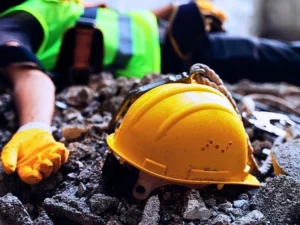Workers in meatpacking and poultry plants are often exposed to dangerous levels of chemical ammonia used in refrigeration systems. Exposure can result in serious and fatal injuries.

Chemical Hazards in Meatpacking Plants
Most meatpacking and poultry plants have refrigeration systems that contain large amounts of chemical ammonia, often as much as 10,000 or more pounds in a single plant. As long as plant refrigeration systems are working and maintained properly, chemical ammonia does not pose health risks to workers. If systems malfunction or are poorly maintained, chemical ammonia can be released into the air resulting in serious injuries and fatalities to plant workers. Chemical ammonia is highly flammable and highly corrosive to the eyes, lungs, and skin. Prolonged exposure can result in permanent injuries, disabilities, and death.
Meatpacking plants can expose workers to hazardous chemicals. Workers in meatpacking plants, poultry processing plants, and food production facilities are often exposed to chemicals found in cleaning products, water disinfectants, carcass washes, and refrigeration systems. Hazardous chemicals are often used in the form of liquids, mists, vapors, and gases. Meatpacking plants use liquified or chemical ammonia that produces a toxic gas.
To ensure the safety of plant workers, the Occupational Safety and Health Administration (OSHA) imposes strict requirements for companies that use hazardous chemicals in the workplace. In meatpacking plants, the maximum amount of hazardous chemicals and flammable liquids and gases is 10,000 pounds. Employers are required to check refrigeration systems on a regular basis to look for leaks and cracks. To protect workers from exposure to hazardous chemicals, employers must take necessary steps to ensure the safety of their refrigeration equipment and other chemical systems that contain highly hazardous chemicals like anhydrous ammonia.
Recently, OSHA cited a San Angelo, Texas meatpacking facility, 7 S Packing LLC, for exposing workers to hazardous chemicals in the workplace. OSHA cited the plant for failing to implement required safety procedures while operating their ammonia refrigeration system which contained more than 10,000 pounds of anhydrous ammonia. The plant was also cited for failure to provide mandatory respiratory protection and fall equipment to plant workers. As a result, the meatpacking plant faces $615,640 in fines and penalties.
Health Effects of Hazardous Workplace Chemicals
Exposure to hazardous chemicals can have various effects on health, depending on:
- The type of chemical
- The form of the chemical (liquid, mist, vapor, gas)
- How the chemical enters the body (ingestion, breathing, absorption through the skin)
- The amount of chemical exposure
- The length of time of the exposure
Depending on the above factors, chemicals can have short-term or acute effects that show up immediately or long-term chronic effects that don’t show up right away. For some workers, acute symptoms disappear when exposure to the chemical returns to safe levels or stops. When workers are exposed to a hazardous chemical, even at low levels, over an extended period of time, they often experience chronic health problems that can show up years after initial exposure. When workers are exposed to high levels of anhydrous (gaseous) ammonia found in meatpacking plant refrigeration systems, injuries are often severe or fatal.
Workers Comp Claims in Illinois
In Illinois, workers exposed to hazardous substances in the workplace are entitled to workers compensation benefits for occupational illnesses and injuries, whether the illness or injury is caused by a single exposure or long-term exposure. Available benefits may include:
- Covered expenses for medical treatments and care, diagnostic X-rays, physical therapy, medications, and necessary medical equipment
- Temporary disability benefits to cover the loss of income during the treatment and recovery period while a worker cannot perform his/her duties
- Permanent total disability or partial disability benefits to compensate for bodily impairment due to hazardous chemical exposure
In Illinois, workers compensation claims are not based on fault. Even when an employer takes all necessary precautions to prevent possible exposure to hazardous substances in the workplace, a worker can still receive benefits, if illness or injury occurs. If a Chicago workers comp lawyer can show that exposure caused the worker’s illness or injury, the employer does not have to be proven negligent.
When filing a claim with a workers comp lawyer in Illinois, the employer must be notified of the work-related exposure or injury within 45 days, either verbally or in writing, or a worker may lose some or all of his/her benefits. Workers should seek Immediate medical treatment for illness or injury to establish a legitimate claim.
Occupational illness and injury claims must be filed within three years after the date of exposure to a hazardous substance that is linked to illness, injury, or disease. If benefits are denied, an appeal can be filed through a workers comp lawyer or the Commission within three years after the date of injury or disability, or within two years after the last compensation payment, whichever comes later.







